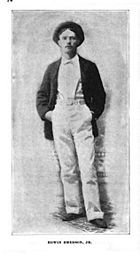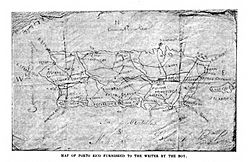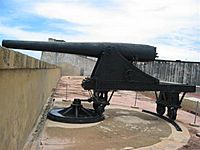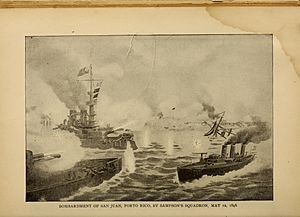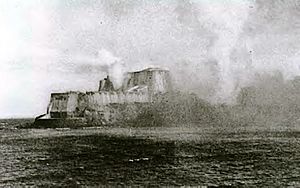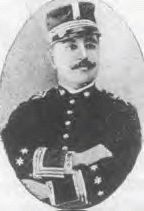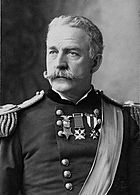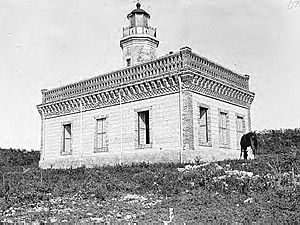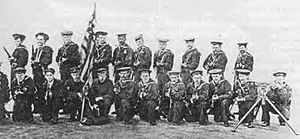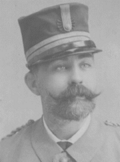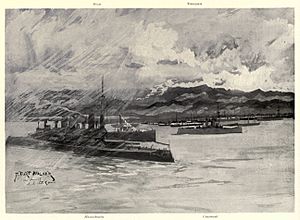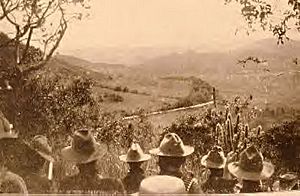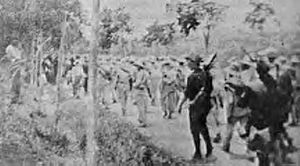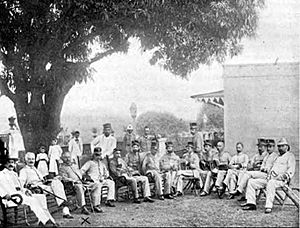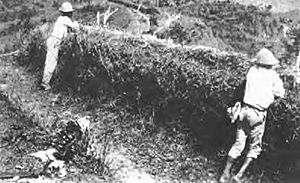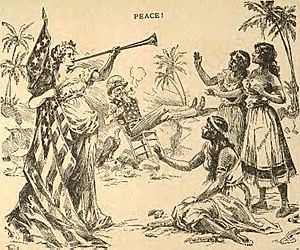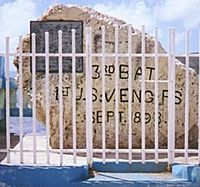Puerto Rico campaign facts for kids
Quick facts for kids Puerto Rico campaign |
|||||||
|---|---|---|---|---|---|---|---|
| Part of the Spanish–American War | |||||||
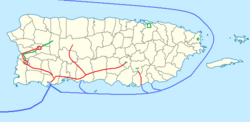 Map of the Puerto Rico campaign illustrating operations July 25 – August 12, 1898, and showing municipality borders in 1898. Blue are US Naval forces, red are US land forces, and green are Spanish ground forces.  Map of Puerto Rico under the US and Spanish flags from August 14 til September 19, 1898. The 23 blue-colored municipalities were under the US flag and the 55 yellow-colored municipalities were under the Spanish flag |
|||||||
|
|||||||
| Belligerents | |||||||
|
|||||||
| Commanders and leaders | |||||||
| Strength | |||||||
| Spain: 8,000 Puerto Rico: 10,000 |
15,472 | ||||||
| Casualties and losses | |||||||
| 17 killed 88 wounded 324 captured 10,000 surrendered at the end of the campaign |
3 killed 40 wounded (mostly by Puerto Rican irregular troops) |
||||||
The Puerto Rico campaign was a military operation by the United States on the island of Puerto Rico during the Spanish–American War. This war took place in 1898. The campaign started on May 12, 1898, when the United States Navy attacked San Juan, the capital. The attack caused little damage, but the Americans created a blockade in San Juan Bay. On June 22, Spanish ships tried to break the blockade but failed.
The land invasion began on July 25. About 1,300 American soldiers, led by Major General Nelson A. Miles, landed in Guánica. After a small fight, the Americans moved towards Coamo. Here, they fought against Puerto Rican and Spanish troops. The allied soldiers retreated, and the Americans took control. The U.S. also took Fajardo on August 1. However, they had to leave on August 5 when 200 Puerto Rican-Spanish soldiers took it back. Many civilians fled during this time.
As American troops moved deeper into the island, they met more resistance. They had battles near the Guamani River and in Coamo. In both cases, the Spanish forces retreated. A battle in San Germán also ended with the Spanish retreating to Lares.
On August 9, 1898, American troops faced strong resistance in Aibonito. Six American soldiers were injured, and they had to retreat. Three days later, they returned with more artillery. After about an hour of fighting, the Spanish guns were silenced. However, all military actions in Puerto Rico stopped on August 13. This happened because U.S. President William McKinley and a French ambassador signed an armistice. This agreement meant Spain gave up control of Puerto Rico, Cuba, the Philippines, and Guam.
Contents
Why the War Started
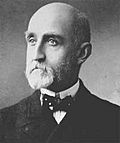
In 1890, Captain Alfred Thayer Mahan wrote a book called The Influence of Sea Power upon History. He believed the U.S. needed a large navy, like the British Royal Navy. Part of his plan was for the U.S. to get colonies in the Caribbean Sea. These colonies would be used as places for ships to refuel and as naval bases. They would also be important for defending a future canal, like the one in Panama.
This idea wasn't new. Earlier, William H. Seward, a former Secretary of State, had also suggested building a canal. He also thought the U.S. should take over the Dominican Republic and buy Puerto Rico and Cuba. The U.S. Senate did not approve taking the Dominican Republic. Spain also refused to sell Puerto Rico and Cuba for $160 million. Mahan explained that without overseas bases, U.S. warships would be like "land birds," unable to travel far.
Since 1894, the Naval War College had been planning for a war with Spain. By 1896, they had plans for military actions in Puerto Rico. Puerto Rico and Cuba were important not just for naval reasons. They also had a lot of sugar, a valuable product the U.S. needed.
On February 15, 1898, the USS Maine exploded and sank in Havana Harbor, Cuba. The U.S. blamed Spain and demanded they leave Cuba. Spain then broke off diplomatic relations. On April 23, 1898, Spain declared war. Two days later, the U.S. Congress declared that war had started on April 20. One main goal for the U.S. in this war was to take control of Spanish lands in the Atlantic (Puerto Rico and Cuba) and the Pacific (the Philippines and Guam).
On April 27, U.S. ships bombarded Spanish forts in Cuba. By July 16, an armistice was signed in Cuba, ending fights there. The U.S. then focused all its military efforts on Puerto Rico. Puerto Rican leaders, like Dr. Julio J. Henna, had already asked President McKinley to include Puerto Rico in any plans for Cuba. They even gave the U.S. information about Spanish troops on the island.
Spain Gets Ready for War
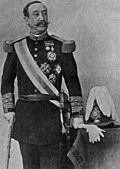
On April 21, 1898, the official newspaper of Puerto Rico announced martial law. This meant that normal constitutional rights were suspended to prepare for war.
When the war began, Spain sent its 1st, 2nd, and 3rd Puerto Rican provisional battalions to defend Cuba. This left fewer Puerto Rican troops on the island itself. The 1st Puerto Rican Provisional Battalion fought American forces in the Battle of San Juan Hill in Cuba. After this battle, 70 Puerto Rican soldiers were killed, wounded, missing, or captured. The Spanish Governor of Puerto Rico, Manuel Macías y Casado, declared martial law. He wanted to resist the American forces. He said he hoped the Spanish language and flag would never disappear from these lands. Macías y Casado believed that giving Puerto Rico some self-rule would make its people stay loyal to Spain.
America Gets Ready for War
On May 24, 1898, Henry Cabot Lodge wrote to Theodore Roosevelt, saying, "Porto Rico is not forgotten and we mean to have it."
Spain did not know that the U.S. had spies on the island. These spies included Henry Howard Whitney and Edwin Emerson, Jr..
According to a story in Century Magazine in September 1898, Edwin Emerson, Jr., pretended to be a German journalist. He asked the German Consul in St. Thomas for names of Puerto Ricans of German descent to interview. One name was the Riefkohl family in Maunabo. In Maunabo, he met 14-year-old Rudolph W. Riefkohl. Emerson asked him in German if he had a map of Puerto Rico, as he had lost his own. Rudolph drew a new map showing the main ports and harbors. Emerson used this map. Some believe it helped General Nelson A. Miles decide where to land troops for the invasion. A copy of Rudolph's map was published in the Century article.
The first fight happened on May 8, 1898. The American ship USS Yale captured a Spanish cargo ship, Rita, in San Juan Bay. On May 9, Yale had a short battle with the Spanish ship Alfonso XIII. The Spanish ship won this small fight. Around this time, Captain Ángel Rivero Méndez was in charge of Spanish forces at San Cristóbal in San Juan. On May 10, when Yale returned, Rivero-Méndez ordered his men to fire on the ship with a large cannon. This was the first attack against American forces in Puerto Rico during the war. Rivero-Méndez received an award for his actions.
Bombardment of San Juan
The Bombardment of San Juan was an American naval attack on the forts of San Juan, Puerto Rico. American naval commanders thought the main Spanish fleet was heading to Puerto Rico. So, Rear Admiral William T. Sampson and ten American warships sailed from Havana on May 2 towards Puerto Rico. Sampson wanted to stop the Spanish fleet and then attack San Juan's forts. He didn't know that the Spanish fleet had already gone to Santiago de Cuba.
On May 12, Sampson's ships arrived at San Juan. The harbor was empty. Sampson decided to bombard the city's forts anyway, as practice for his gunners. Captains Ramón Acha Caamaño and José Antonio Iriarte defended the city from Castillo San Felipe del Morro. They had three cannon batteries. The battle lasted three hours. Justo Esquivies, the first Puerto Rican soldier to die in the campaign, was killed. Caamaño also received an award for his bravery.
After damaging the Spanish defenses, and with their own ships slightly damaged and low on coal, Sampson ordered a stop to the firing. He returned to Havana and then to Key West, Florida, for repairs.
Second Battle of San Juan
On June 22, 1898, USS Saint Paul, led by Captain Charles Sigsbee, arrived at San Juan Bay. It joined the blockade. Soon after, the old Spanish cruiser Isabel II sailed out to fight Saint Paul. Shore batteries supported the Spanish ship. Isabel II fired at Saint Paul from far away but missed. The Spanish destroyer Terror, which was in San Juan for repairs, tried to help. It attempted a torpedo attack. But Terror's rudder was hit by Saint Paul, damaging it. Terror lost control and was hit again near its waterline, disabling an engine. Terror stopped its attack and returned to port, followed by Isabel II. On June 26, USS Yosemite took over the blockade of San Juan Bay.
Third Battle of San Juan
On June 28, 1898, the American ship USS Yosemite fought a group of Spanish warships. This group included a cruiser, two gunboats, and a blockade runner. During the fight, the SS Antonio López, a Spanish cargo ship carrying important military supplies, was chased by Yosemite. The Spanish ship ran aground near Ensenada Honda, Puerto Rico. Captain Caamaño was in charge of saving the ship's cargo. His men quickly removed most of the valuable supplies. Only a few small items and a cannon were lost.
On July 15, the cruiser USS New Orleans arrived. The next day, it finished off the Antonio Lopez by firing incendiary shells and sinking it. Even though the ship sank, its cargo was saved. This meant that any American attack on San Juan would face stronger resistance. Caamaño received another award from the Spanish government.
The people of San Juan were angry with Captain Rivero-Méndez. They blamed him for the damage caused by American bombardments. After the Treaty of Paris of 1898 was signed, Captain Rivero-Méndez was ordered to give the keys to all military buildings in San Juan to the U.S. Army.
Land Campaign in Puerto Rico
Landing in Guánica
Spanish forces expected the Americans to attack the northern part of the island. So, they focused their defenses around San Juan and Arecibo. They also knew about a planned landing at Fajardo on the east coast and had fortified that town. However, the southern and western parts of Puerto Rico had very few defenses.
After Cuba was captured, President William McKinley approved a land invasion of Puerto Rico. He thought the Americans should land at Fajardo, since San Juan was well-defended. A group of ships left Tampa, Florida. On July 21, another group, including USS Yale, USS Massachusetts, USS Gloucester, and USS Dixie, sailed from Guantánamo for Puerto Rico.
Major General Nelson A. Miles was on USS Yale. As they neared Puerto Rico, Miles decided to land his troops in the southern part of the island. He chose Guánica as the landing spot. Miles sent boats to tell the other ships about his change of plans. He believed Fajardo would be too strong and feared Spanish gunboats there.
On July 25, General Miles arrived at Guánica Bay with 1,300 infantry soldiers. Naval Captain Francis J. Higginson commanded the ships. The convoy included several Navy ships and Army troop transports.
In 1898, Guánica was a small area within the town of Yauco. It had only 60 houses. Its only defense was eleven members of a Puerto Rican militia unit, led by Lieutenant Enrique Méndez López. When the Guánica lighthouse keeper, Robustiano Rivera, saw the ships, he warned the residents. All residents, except for a few who welcomed the invaders, left their homes. Rivera went to Yauco to tell the mayor about the invasion.
First Fight in Guánica
Gloucester was the first ship to drop anchor in Guánica Bay. Twenty-eight sailors and Marines, led by Lieutenants H. P. Huse and Wood, landed on the beach. The Marines took down the Spanish flag and raised the American flag. They then set up a machine gun nest and barbed wire. The first land fight in Puerto Rico happened when Lt. Méndez López and his men attacked the Americans. The Americans fired back with their machine gun, and Gloucester bombarded the Spanish position. Lt. Méndez López and three of his men were wounded. The militia had to retreat to Yauco.
The Invasion Continues
After the fight, more American soldiers landed to secure the area and build a dock. In total, 3,300 American soldiers under General Miles landed. The units included volunteer regiments from Illinois and Massachusetts, artillery, and engineers. The few people who stayed in Guánica swore loyalty to the United States. General Garretson named Agustín Barrenechea as mayor of Guánica. On the afternoon of July 25, Garretson left Guánica with some troops and headed towards Yauco.
Secretary of War Russell A. Alger learned about the landing in Guánica the next day from a newspaper. The War Department had told Miles to invade San Juan, so Alger was surprised. Miles would have faced trouble if the invasion hadn't gone so well. Three days after the invasion, Alger received a cable from Miles saying: "Spanish troops are retreating from southern part of Puerto Rico. This is a prosperous and beautiful country. The Army will soon be in mountain region. Weather delightful; troops in the best of health and spirit. Anticipate no insurmountable obstacles in future results. Results thus far have been accomplished without loss of a single life."
Battle of Yauco
After the Guánica lighthouse keeper told the mayor of Yauco about the invasion, the mayor informed Governor Macías. Governor Macías ordered Captain Salvador Meca and his troops from Yauco to go to Guánica. Lieutenant Colonel Francisco Puig joined them and took command of the Spanish forces. Puig had two companies and was joined by Puerto Rican volunteers and local militia. Puig placed his men along the road from Guánica to Hacienda Desideria in Yauco.
Meanwhile, General Garretson and his men left Guánica for Yauco. They wanted to capture the Yauco train station, which connected to Ponce. Garretson's scouts warned him about possible enemy forces at Hacienda Desideria. He ordered some of his troops to take a small hill overlooking the hacienda.
Captain San Pedro saw the American troops moving and ordered his men to fire. Garretson then ordered a direct attack on the Spanish and Puerto Rican forces. At dawn, the 6th Massachusetts overran the Spanish forces. Four Americans were injured. Puig was expecting help from Yauco, but it didn't arrive. He was ordered to retreat. Before leaving, part of the Spanish force attacked the American positions. The Spanish forces were eventually driven back. Puig's forces had two officers and three soldiers wounded, and two soldiers killed.
Puig and his men retreated towards Yauco. They failed to destroy the train station that connected Yauco to Ponce. They then marched towards Peñuelas. Garretson's troops entered Yauco on the afternoon of July 26. Puig's men continued their march, leaving their heavy equipment behind. They passed through Adjuntas and Utuado, finally reaching Arecibo on the northern coast on July 29. Colonel Puig, fearing he would be blamed for abandoning equipment, died on August 2.
General Miles ordered an investigation into the 6th Massachusetts' discipline during the battle. As punishment, the 6th Massachusetts was sent on a difficult march from Guánica to Ponce. Their commander and other officers resigned.
Battle of Fajardo
On August 1, several American ships were sailing off the coast of Fajardo. Captain Frederick Rodgers spotted the "Faro de Las Cabezas de San Juan" (lighthouse), which was the planned landing site for the U.S. Army. Rodgers sent a small group ashore to explore. These sailors, including Puerto Rican volunteers, advanced close to Fajardo. However, they met Spanish troops and retreated.
The 25-man Spanish garrison in Fajardo was warned about the Americans. They were ordered to leave after telling their superiors in San Juan. Dr. Santiago Veve Calzada, a local from Fajardo, saw that the town was defenseless. He asked Spanish authorities in San Juan to send troops. When no help came, Veve went to the lighthouse to ask the Americans for protection for his town. On August 5, Veve entered Fajardo with American sailors. U.S. flags were raised over the Customs House and City Hall. On August 6, Captain Charles J. Barclay ordered sailors to relight and occupy the Fajardo Light. They also brought 60 women and children from families who had sided with the Americans to the lighthouse for safety. As the first sailors entered the dark lighthouse, Naval Cadet William H. Boardman was badly wounded when his revolver accidentally fired, hitting his leg. He later died. This was one of only two Navy deaths during the Puerto Rico campaign.
On August 4, Governor General Manuel Macías y Casado sent Colonel Pedro del Pino and about 220 troops to retake the city. When Colonel Pino entered Fajardo on August 7, it was almost empty. The residents had fled to the lighthouse and nearby hills, fearing a battle. Close to midnight on August 8, Pino's troops attacked the lighthouse. The American sailors inside turned off the light and signaled their ships offshore. The naval guns began firing to protect the lighthouse. After two hours, the Spanish forces retreated back to the town. The Americans had no casualties. The Spanish lost two dead and three wounded.
The next morning, Barclay decided that holding the lighthouse was not very important. He ordered his men back to the ship. A group of sailors and U.S. Marines came ashore to secure the area. The 60 Fajardan civilians boarded a ship to Ponce. The lighthouse was left to the Spanish. In Fajardo, Pino's men took down the U.S. flags and returned to San Juan. About 20 civil guards stayed behind to keep order. The fight at Fajardo was the only time American forces left a position during the Puerto Rico campaign.
Battle of Guayama
After Yauco was taken, Miles decided to attack Ponce by sea and land. General Garretson's troops returned to Guánica. After resting, they were ordered to move east to Ponce. Lt. Col. Rafael Martinez Illecas, who was in charge of Spanish forces in Ponce, had left the city. He left behind a small group of 300 volunteers. When the Americans arrived in Ponce, they met no resistance, and the Spanish volunteers surrendered. American forces were not alone in taking Ponce. Members of the Puerto Rican Commission, including Antonio Mattei Lluberas, arrived in Ponce. General Miles organized the "Porto Rican Scouts" from this group. Miles then ordered Brigadier General Peter G. Hains and his regiments to take Arroyo. Arroyo was a small port east of Ponce that served the larger town of Guayama. Arroyo was taken on August 2. On August 5, Hains ordered troops to capture Guayama.
Spanish forces were dug in on two small hills, with the road from Arroyo to Guayama running between them. The Americans crossed a stream in front of the hills when the Spanish suddenly opened fire. The Americans used the stream for cover and increased their firing as more troops arrived. The Spanish troops were outnumbered and retreated to Guayama as the Americans advanced. The fight lasted half an hour, leaving three Americans wounded. When the 4th Ohio entered Guayama, they found that the Spanish had fled north and left the city. This ended the Battle of Guayama. General John R. Brooke used the Cautiño Residence in Guayama as his military headquarters.
Battle of the Guamaní River Bridge
On August 6, Colonel Coit sent two companies of the 4th Ohio on a scouting mission. They went across and beyond a bridge over the Río Guamaní (Guamaní River). This road was important for General Hains' plan to advance to Cayey. The 4th Ohio saw Spanish troops dug in at Guamaní Heights, six miles north of the bridge. The 4th Ohio felt the Spanish were too strong to attack then. They asked for more troops. On August 9, they attacked the Spanish, and a short fight broke out. The Americans had more soldiers, forcing the Spanish to retreat from Guamaní Heights. This battle was the costliest for the Americans since landing at Guánica, with seven wounded. The Spanish forces had 2 dead and 15 wounded.
Battle of Coamo
Soon after the Americans landed, Spanish and Puerto Rican units moved from Ponce to Aibonito. They marched along the Carretera Central (Central Road). This group included two companies of the Batallón de Cazadores de la Patria and members of the Civil Guard and a Puerto Rican guerilla force. In total, 248 infantry men and 42 cavalry members were led by Lt. Col. Rafael Martínez Illescas. The group decided to spend a night at the Baños de Coamo resort. Martínez Illescas immediately ordered trenches to be built. While building them, they were attacked by an anti-Spanish guerilla force, which killed a Civil Guard member.
Meanwhile, two American volunteer battalions from Wisconsin and Pennsylvania, led by Generals Oswald H. Ernst and James H. Wilson, took positions near Coamo. On August 9, 1898, the Americans began their attack. They fired cannons at the city, damaging the resort. The Americans planned to surround the city's defenses. A group of soldiers entered the city from the back, moving through a nearby river. This attack from the rear was supported by Wilson's army, trying to trap the allied soldiers. Martínez Illescas was surprised. He led an improvised attack but was killed along with his second-in-command. Captain Hita took charge and ordered his men to surrender. Half of the allied troops ignored the order and continued fighting. Hita's men were sent to a prisoner-of-war camp. The men who continued fighting retreated to Aibonito when they realized they were being surrounded.
Battle of Silva Heights
Brigadier General Theodore Schwan and 2,896 men landed in Guánica and marched towards Yauco. Schwan and his men were ordered to move west and capture Mayagüez. Colonel Julio Soto Villanueva ordered 1,500 Spanish Regulars and other Spanish and Puerto Rican forces from Mayagüez to meet and defeat Schwan. The Spanish forces dug in at a high ridge called Silva Heights, near Hormigueros.
Schwan's troops arrived in San Germán and continued towards Mayagüez. Schwan's cavalry approached Silva Heights and were met with Spanish gunfire. American forces, supported by artillery and Gatling guns, helped. The Spanish forces retreated under heavy fire. Schwan's men camped at Silva Heights for the night. The next day, they continued to Mayagüez. They found that the Spanish forces had left the city and retreated east towards Lares. Schwan sent forces to follow and capture Soto Villanueva. The Battle of Silva Heights resulted in 3 Spanish dead, 6 wounded, and 136 prisoners. Schwan's brigade had 15 wounded and 2 killed.
Battle of Asomante
American cavalry chased the soldiers who had retreated from Coamo. They caught up with them in Aibonito Pass, also known as Asomante. Puerto Rican and Spanish troops had prepared this area. They built trenches and placed soldiers and equipment among the trees. As soon as they saw the American troops, they opened fire with cannons. The American cavalry received infantry support, which was met with more cannon fire. Six American soldiers were injured, and a retreat was ordered. The allied units (Spanish and Puerto Rican) lost five soldiers and two civil guards. For the next two days, the Americans scouted the battlefield. Spies were sent into Coamo, including a Puerto Rican separatist who got defense plans from a teacher. The Puerto Rican soldiers in Asomante did patrols and ate simple food.
American commanders decided to attack the trenches with artillery. They also sent a large group to Barranquitas to attack the allied troops from behind. At 10:30 a.m., Captain R.D. Potts led part of the 3rd Wisconsin Volunteer Infantry Regiment towards Aibonito. At 1:00 p.m., the allied troops opened cannon fire as the Americans came into range. Potts ordered two batteries to be set up. Shrapnel from allied cannon fire fell near the American commander, who asked for more artillery support. One of the Spanish cannons overheated, forcing a temporary stop to their firing. The American commander thought the enemy was defeated and ordered an advance. However, the allied fire started again, now with Mauser rifle fire. This sudden attack confused some American soldiers. Fearing the allied units might capture American equipment, a retreat was ordered. Lieutenant Hains was badly injured by a Mauser bullet. Most of Potts' men fled the battlefield. The allied forces overpowered the American infantry, using Mauser fire to disrupt their artillery. Four American officers and several soldiers were badly injured, with one soldier dying. The allied units had only one injured artillery man.
General Miles sent a telegram to Wilson's camp, telling him the war had ended. The Americans sent a messenger to Asomante, but the Spanish commander refused to stop fighting. All military actions in Puerto Rico were supposed to stop on August 13. This was because President William McKinley and a French ambassador signed an armistice. However, a final small fight happened on the same day.
The Guacio Disaster
The Mayagüez army marched for two days after leaving the city. On August 11, Colonel Soto Villanueva was injured in the leg after falling through a bridge. He believed his leg was broken and had to be carried. The army reached Las Marias that day. Soto Villanueva decided to make a final stand there. He sent a telegram to General Macias, but Macias ordered him to continue marching to Lares. Feeling unable to lead, Soto gave command to Lieutenant Colonel Oses. Oses followed the governor's order. However, on August 12, the army was stopped by the roaring Guacio River, which was too big to cross. Oses ordered the army to wait until morning. On August 13, the river was still high. Colonel Suau remembered another crossing north of the river. At 9:00 a.m., he ordered his troops to march north to cross there. At this point, American troops were seen, and the battle began. Oses saw that victory was unlikely. He ordered Lieutenant Olea to fire cannons at the Americans while his forces tried to cross the river. In the chaos, Oses and most of the Spanish forces were captured. They were taken prisoner and marched back to Mayagüez. Colonel Suau's forces found the crossing and retreated. They successfully reached Lares, where they learned about the surrender. Schwan wanted to chase the remaining forces but stopped when he heard about the armistice. The battle at Las Marias was seen as a huge military failure by the Spanish and local people. They called it the Guacio Disaster.
What Happened Next
Treaty of Paris of 1898
The Puerto Rico campaign lasted from May 8 to December 10, when the Treaty of Paris was signed. It was shorter than other campaigns in the Spanish–American War. One reason it was short was that many Puerto Ricans in the southern and western towns disliked Spanish rule. They often saw the Americans as liberators. The Treaty of Paris officially took effect on April 11, 1899. Some Puerto Rican leaders, like José de Diego, hoped the United States would give the island its independence. A group of men even started an uprising in Ciales, calling Puerto Rico a republic. Spanish authorities, not knowing about the cease-fire, stopped the uprising harshly. Another reason the campaign was short was that many Puerto Rican battalions were in Cuba, fighting the Americans there.
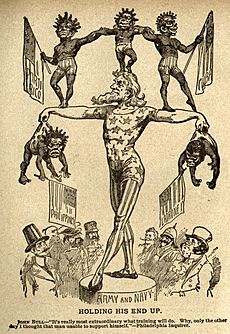
The Puerto Rican Battalion in Cuba had 70 casualties (dead, wounded, missing, or captured). In total, 33,472 people fought in the Puerto Rico campaign. This included 8,000 Spanish, 10,000 Puerto Rican, and 15,472 American soldiers. The Spanish and Puerto Rican forces had 429 casualties: 17 dead, 88 wounded, and 324 captured. The American forces had 43 casualties: 3 dead and 40 wounded. Julio Cervera Baviera, a Spanish commander, wrote a pamphlet blaming Puerto Rican volunteers for Spain's defeat. Angry people in San Juan wanted to challenge him to a duel, but he explained his intentions, and the matter was settled.
Under the Treaty of Paris of 1898, Puerto Rico was given to the United States. Spain lost its last colony in the Western Hemisphere. The United States gained more power and a global presence. The U.S. set up a military government in Puerto Rico. Miles was appointed as the first head of this government. Spanish soldiers and civilians loyal to Spain could return to Spain. By October 18, the Spanish withdrawal from Puerto Rico was complete. Spanish military members who stayed in Puerto Rico were offered a chance to serve in the new "Porto Rico Regiment." Some, like Teófilo Marxuach, joined. Others, like Captain Angel Rivero Méndez, retired from the military.
"Americanization" of Puerto Rico
From 1898 to 1900, four military officers governed Puerto Rico. These included General Nelson A. Miles and Major General John R. Brooke. These officers were experienced in dealing with Native Americans. However, the U.S. Army had no experience governing overseas territories. One general said it was a completely new duty for American officers.
The U.S. Department of War's Division of Insular Affairs managed Puerto Rico. This division was similar to the Bureau of Indian Affairs. The United States quickly began to make Puerto Rico more "American." The U.S. occupation changed Puerto Rico's economy and government. It did not apply democratic principles to the island. Puerto Rico was called an "unincorporated territory." This meant that the protections of the U.S. Constitution did not automatically apply. The island belonged to the U.S., but it was not considered part of the U.S.
In 1899, U.S. Senator George Frisbie Hoar described Puerto Ricans as "uneducated, simple-minded and harmless people." He suggested that Spanish should be removed from schools and only English taught. Schools became the main way to Americanize the island. At first, all classes were taught in English, which caused many students to drop out.
On January 15, 1899, the military government changed the island's name to Porto Rico. (On May 17, 1932, the U.S. Congress changed it back to "Puerto Rico.") The island's money was changed from the Puerto Rican peso to the American dollar. The U.S. controlled Puerto Rico's economy. It stopped Puerto Rico from making trade deals with other countries. It also controlled tariffs and shipping goods to the U.S. mainland.
Civil Disorder
After the U.S. invasion, there was civil disorder in the island's mountains. Local people, who were now unemployed, formed groups called "Partidas." These groups first attacked and robbed wealthy plantation owners who were loyal to Spain. Later, they also attacked businesses owned by local people. One famous leader was José Maldonado Román, also known as 'Aguila Blanca'. He operated near Juana Díaz and Ponce. He bothered the Spanish Civil Guard and later the American forces.
Another reason for the disorder was the lack of discipline among American volunteer troops. These soldiers were not professional. Many reports showed them acting disorderly and fighting with local residents. The civil disorder ended when the military government began to rebuild Puerto Rico's infrastructure. This created jobs for many unemployed people. Also, the volunteer troops were replaced by the regular Army.
End of Military Rule and Rise of Sugar
Military rule was replaced by a civilian government through the Foraker Act of 1900. However, this Act stated that the governor, police chief, and top officials would be appointed by the U.S. President. All of them had to be Americans.
In 1901, the first civilian U.S. governor of Puerto Rico, Charles Herbert Allen, became president of the world's largest sugar-refining company, the American Sugar Refining Company. This company later became Domino Sugar. Charles Allen used his position as governor to gain control over Puerto Rico's entire economy.
Puerto Rico Today
In 1947, the U.S. gave Puerto Ricans the right to elect their own governor. The first election was in 1948. The Constitution of Puerto Rico was approved in 1952. Puerto Rico adopted the name Estado Libre Asociado, which means "Free Associated State." In English, it is officially called a Commonwealth.
Markers and Monuments
In Puerto Rico, there are no specific monuments for the Spanish–American War. However, there are markers where historical events happened. There are also tombstones honoring both American invaders and Spanish and Puerto Rican defenders. In Guánica, a rock on the coast has an inscription. It shows where Major General Nelson A. Miles and his men landed. There is also a monument in Guánica for Spanish–American War veterans. It doesn't say if it's for Americans or Spanish/Puerto Ricans. In Yauco, there is a monument for an unknown Spanish soldier who died in combat.
In Coamo, two markers show where Rafael Martínez Illescas and Frutos López died. López's tomb is in the old cemetery of Coamo, next to three unknown Puerto Rican soldiers. Martínez Illescas' body was moved to Spain in 1916. The town of Guayama has a monument for the 4th Ohio Infantry. In Asomante, a marker shows where the "Battle of Asomante" took place.
See also
 In Spanish: Guerra hispano-estadounidense en Puerto Rico para niños
In Spanish: Guerra hispano-estadounidense en Puerto Rico para niños



